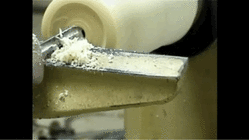I thought it was not safe for hollowing? I want to try this project. Would bowl gouge be more safe? How would you do it?
Guy on you tube making scoops
Guy on you tube making scoops
Oh I didn't know I could do it just with scraper. That sounds better.Forstner is fine for hogging out material, but dosen't leave a very nice bottom for a scoop. Get one without a point, or file the point off to leave a flat bottom. I'd prefer a rounded cup shape in the inside of a scoop myself. A round scraper will do it nicely and easily.
Here's a link to a video of Raffin doing it:View: https://www.youtube.com/watch?v=46F7AnY8I9A
Good answers above it is hollowing a spindle.I thought it was not safe for hollowing? I want to try this project. Would bowl gouge be more safe? How would you do it?
Guy on you tube making scoops

Cue Robo Hippy.Oh I didn't know I could do it just with scraper. That sounds better.
